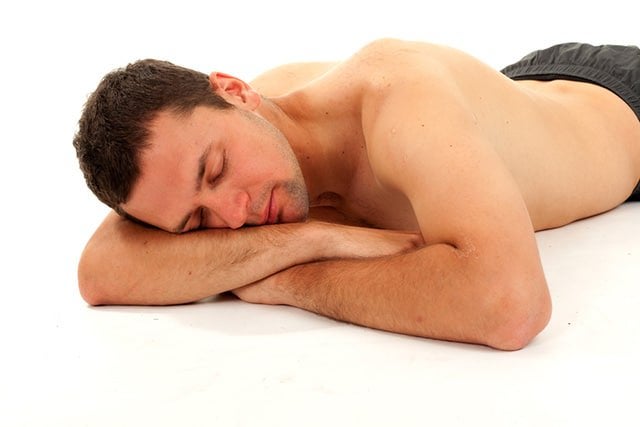What a day it has been and you’re finally lying in bed. Face clear, sheets smelling lavender, the entire house is sunk in silence. But you aren’t able to relax, just like you couldn’t the night before. Maybe your legs are hurting, maybe you’ve had too much to eat for dinner, or maybe there’s something at work or the kids acting out that are stuck in the back of your mind.
Ah, your mind… always looking for solutions. And that is what keeps you up at night. When melatonin supplements fail, is it possible for other methods to help you fall asleep in 1- seconds?
Military Methods for Falling Asleep Fast

Fall Asleep in Two Minutes
Let’s start off by showing you some methods that will help you fall asleep in 120 seconds.
#1: Staying awake.
- There is a little something called paradoxical intention, which suggests that telling yourself to stay awake for longer might actually help you fall asleep faster.
- If you suffer from insomnia, you might increase your performance anxiety while trying to sleep.
- According to research, you are more likely to fall asleep while telling yourself that it’s best to stay awake.
#2: Acupressure practices.
It’s important to note that there isn’t any solid scientific evidence that acupressure can actually put you to sleep. The little research that is available does show some promising results. The whole idea is to identify tense body points.
- There is a technique called spirit gate that goes something like this: hold out the palm of your hand and identify the follow space underneath it, which should be located on the side of your pinky. Apply pressure on that area using circular movements for about three minutes. While looking at the palm of your hand, press down the left side of the previously-identified point for a few seconds. Then, hold the right side that’s under the back of your hand. Repeat the steps for the other wrist as well.
- The wind pool technique is focused on applying pressure to the back of your head. Create a cup shape using both of your hands by interlocking your fingers. Place your thumbs at the base of your skull. Your thumbs should touch where the head and neck are connected. Apply firm pressure and massage this area by using up and down or circulation motions. Inhale and pay close attention to how your muscles relax when you exhale.
- The third method is the inner frontier gate. Stretch out the palm of your hand just as you did for the spirit gate method. Identify the spot that’s located three finger-width down and using your wrist crease as a starting point. Using your thumb, identify the spot between the two tendons and apply steady pressure. Massage the area gently until you can feel your muscles relaxing.
#3: Image distraction.
- Your imagination can go a very long way in you creating a relaxing space to ease your anxiety and chase away insomnia.
- According to a study conducted in 2002, people who turned to image distraction were able to fall asleep faster compared to those with general distraction.
- The whole purpose of this technique is to visualize something pleasant that will allow you to dive into a soothing scenario that will distract you from the pitfalls of negative thoughts. It’s pretty much like meditating.
Fall Asleep in One Minute
If you’ve mastered the techniques needed to get you to fall asleep in two minutes, how about you step up your game and practice falling asleep in 60 seconds? There are two main methods that could help you reach that goal, so let’s get to it.
#1: Breathing method.

- In order to prepare to work on this technique, you have to place the tip of your tongue on the mouth’s roof, right behind the two front teeth. For the remainder of the steps, your tongue has to remain in that position (you can purse your lips if need be).
- To start off one cycle, you have the part your lips slightly and, while you’re exhaling, use your mouth to make a whooshing sound.
- Close your lips and breathe air through your nose as you silently count to four.
- Hold your breath for seven seconds.
- Making the same whoosh sound, exhale for eight seconds (hence the 4-7-8 denomination).
- Repeat the cycle four times, and allow your body to fall asleep if you feel like it. When you’ve mastered this technique, you will be able to practice it mindlessly, without paying too much attention to the sequence of the steps and breathing patterns.
#2: Progressive muscle relaxation.
This is a technique designed to help your muscles unwind and prepare for sleep. However, the purpose of the technique is to cause your muscles to become tense enough to be able to release the tension. when performed correctly, this technique can help you battle insomnia and makes your body feel more at ease. Some suggest that you start off with the aforementioned breathing technique before you move on to progressive muscle relaxation.
- Start off by tightening your forehead muscles by raising your eyebrows as much as you can for about five seconds. When the five seconds are up, relax them immediately and wait for 10 seconds.
- It’s time to move on to your cheeks. Smile as wide as you can until you feel the tension in your cheeks and count to five. Relax your muscles and count to 10.
- Close your eyes and squint. Count to five. Relax and count to ten.
- Tilt your head back so that you can see the ceiling. When you feel the tension in the back of your neck, hold for five seconds. When you relax, you should be able to feel your neck sinking into the pillow again. Relax for 10 seconds.
- The idea is to do this exercise for every group of muscles in your body, continuing with the triceps and going all the way down to your feet. Tense the muscles for five seconds, relax for 10 and move on to the next group. Allow yourself to fall asleep even if you don’t finish tensing.
Fall Asleep in 10 Seconds
Assuming that you’re getting good at these methods and want to fall asleep as fast as possible, let’s talk about the military method, which promises to help you fall asleep in the blink of an eye. This method will require a great deal of practice, so don’t expect it to work the first few times. Note that it will take 120 seconds to actually see this method is true, so it’s actually the last 10 seconds that will put you down.
What you should know about the military method is that it was first mentioned in the book “Relax and Win: Championship Performance.” The method was supposedly created in order to get pilots of the United States Navy Pre-Flight School to fall asleep in 120 seconds.
- Relax all of your facial muscles.
- Release the tension in your shoulders and allow your hands to drop in each side of the body.
- Relax your chest and exhale.
- Relax your thighs, legs, and calves.
- Picture a relaxing image that will allow you to clear your mind for 10 seconds. Alternatively, you can also repeat the words “don’t think” over and over in your mind for 10 seconds.
- Fall asleep and enjoy it!
Conclusion
Falling asleep in 10 seconds sounds like magic, particularly if you’re the kind of person who takes hours from the moment they go to bed until they can actually fall asleep. The thing to remember is that in order to master the 10-second method, it’s advised that you practice the other methods first because it takes time for you to master being able to release tension in your body. Breathing exercises also go a long way.
However, aside from learning how to master these techniques, you should know that there are other elements you need to look out for if you want to increase the odds of falling asleep faster: avoid technology before bed, avoid snacks and going to sleep on a full stomach, avoid noises and distractions that could keep you up, and always pay close attention to your sleep hygiene.


